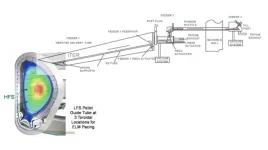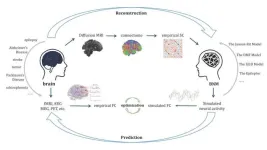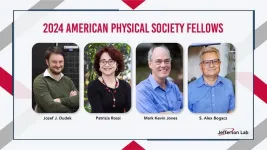(Press-News.org) October 7, 2024—(BRONX, NY)—Metastatic disease—when cancer spreads from the primary tumor to other parts of the body—is the cause of most cancer deaths. While researchers understand how cancer cells escape the primary site to seed new tumors, it’s not well understood why some of these wayward cancer cells spawn new tumors— sometimes decades later—while others do not.
Now, a research team at the National Cancer Institute-designated Montefiore Einstein Comprehensive Cancer Center (MECCC) has discovered a natural immune mechanism in mice that stops escaped cancer cells from developing into tumors elsewhere in the body. The findings were published today in the journal Cell.
“Preventing or curing metastases is the most critical challenge in cancer,” said study leader Julio Aguirre-Ghiso, Ph.D., director of MECCC’s Cancer Dormancy Institute. “We think our findings have the potential to point to new therapies to prevent or treat metastatic disease.” The study’s co-first authors are Erica Dalla, Ph.D., a former student, and Michael Papanicolaou, Ph.D., a postdoctoral fellow in Dr. Aguirre-Ghiso’s lab.
The Role of Dormancy in Cancer
Cells that migrate from primary tumors and seed metastatic tumors are called disseminated cancer cells (DCCs). Some DCCs behave aggressively, immediately starting tumors in new tissue, while others remain in a state of suspended animation referred to as dormancy.
“It’s long been a mystery how some DCCs can remain in tissues for decades and never cause metastases, and we believe we’ve found the explanation,” said Dr. Aguirre-Ghiso, who is also professor of cell biology, of oncology, and of medicine and the Rose C. Falkenstein Chair in Cancer Research at Albert Einstein College of Medicine.
Breast cancer and many other types of cancer metastasize to the lungs. In research involving three mouse models of metastatic breast cancer, Dr. Aguirre-Ghiso and colleagues determined that when breast cancer DCCs spread to the lung’s air sacs (alveoli), they are kept in a dormant state by immune cells known as alveolar macrophages.
Insight into the Immune System
“Alveolar macrophages are the lung’s first responders, defending the organ against bacteria and dangerous substances like environmental pollutants,” said Dr. Aguirre-Ghiso. These specialized macrophages, he notes, appear early in embryonic development and reside within lung tissue for life.
“Our findings demonstrate a new role for these macrophages, in which they recognize DCCs and actively interact with them, and—by secreting a protein called TGF-β2—produce signals in the cancer cells that keep them in a dormant state,” Dr. Aguirre-Ghiso said. “Since every organ in the body has its own set of tissue-resident macrophages, they may function to keep DCCs in check in those organs as well. Our study has shown for the first time that these specialized macrophages function to actively induce dormancy in DCCs.”
Confirming the importance of alveolar macrophages in keeping DCCs dormant, Dr. Aguirre-Ghiso and his team found that depleting them in the mice significantly increased the number of activated DCCs and subsequent metastases in their lungs compared to mice with normal levels of the immune cells.
As DCCs become more aggressive, the researchers found, they become resistant to the pro-dormancy signals produced by alveolar macrophages. Ultimately, this evasion mechanism enables some DCCs to “wake up” from dormancy and reactivate to form metastases.
“Understanding how immune cells keep DCCs in check could lead to new anti-metastatic cell therapies among other strategies,” Dr. Aguirre-Ghiso said. For example, he noted, it may be possible to strengthen macrophage signaling so that DCCs never awaken from dormancy or find ways to prevent older DCCs from becoming resistant to dormancy signaling.
The study is titled, “Lung resident alveolar macrophages regulate the timing of breast cancer metastasis.” Additional authors from MECCC include: Nicole Barth Ph.D (also at University of Edinburgh, UK), Deisy Segura-Villalobos, Ph.D., Luis Valencia-Salazar, B.A., Dan Sun Ph.D., and David Entenberg, Ph.D. Other authors include: Matthew Park, Ph.D., and Miriam Merad, M.D., Ph.D., at Icahn School of Medicine at Mount Sinai, New York, NY, Rui Hou, Ph.D., and Alistair R. R. Forrest, Ph.D., at The University of Western Australia, Nedlands, Australia, and Maria Casanova-Acebes, Ph.D., at Spanish National Cancer Centre, Madrid, Spain.
***
About Montefiore Einstein Comprehensive Cancer Center
Montefiore Einstein Comprehensive Cancer Center (MECCC) is a National Cancer Institute (NCI)-designated comprehensive cancer center and a national leader in cancer research and care located in the racially and ethnically diverse borough of the Bronx, N.Y. MECCC combines the exceptional science of Albert Einstein College of Medicine with the multidisciplinary and team-based approach to cancer clinical care at Montefiore Health System. Founded in 1971 and a NCI-designated cancer center since 1972, MECCC is redefining excellence in cancer research, clinical care, education and training, and community outreach and engagement. Its mission is to reduce the burden of cancer for all, especially people from historically underrepresented groups.
END
Scientists discover that special immune cells stop metastatic cancer
Finding by Montefiore Einstein Comprehensive Cancer Center could point to new approach for preventing or treating metastatic disease
2024-10-07
ELSE PRESS RELEASES FROM THIS DATE:
Cancer biologists discover a new mechanism for an old drug
2024-10-07
Since the 1950s, a chemotherapy drug known as 5-fluorouracil has been used to treat many types of cancer, including blood cancers and cancers of the digestive tract.
Doctors have long believed that this drug works by damaging the building blocks of DNA. However, a new study from MIT has found that in cancers of the colon and other gastrointestinal cancers, it actually kills cells by interfering with RNA synthesis.
The findings could have a significant effect on how doctors treat many cancer patients. Usually, 5-fluorouracil is given in combination with chemotherapy drugs that damage ...
Food deserts, limited access to transportation linked to more complications among preschool children with SCD
2024-10-07
(WASHINGTON – October 7, 2024) - A new study finds that preschool-aged children with sickle cell disease (SCD) who live in food deserts and have limited access to transportation are at greater risk for acute complications and hospitalizations, despite receiving free evidence-based therapy and social support, according to results published today in Blood Advances.
“Despite the level of care received by the families and patients within our clinic, we still have a gap in terms of being able to address the barriers ...
Space oddity: Most distant rotating disc galaxy found
2024-10-07
Researchers have discovered the most distant Milky-Way-like galaxy yet observed. Dubbed REBELS-25, this disc galaxy seems as orderly as present-day galaxies, but we see it as it was when the Universe was only 700 million years old. This is surprising since, according to our current understanding of galaxy formation, such early galaxies are expected to appear more chaotic. The rotation and structure of REBELS-25 were revealed using the Atacama Large Millimeter/submillimeter Array (ALMA), in which the European ...
How a common economic theory could help save endangered frogs
2024-10-07
A common theory that guides financial investment strategies may be a handy tool to protect an endangered Puerto Rican frog. A new study uses modern portfolio theory to identify future “investments” in natural resource management that may help managers decide which actions to take to protect coquí llanero populations in Puerto Rico.
The 17 species of coquí frogs, and their signature high-pitched chirp, are considered unofficial mascots of Puerto Rico. The entire population of coquí llanero frogs, the smallest and possibly most endangered of the island’s coquís, ...
Stopping off-the-wall behavior in fusion reactors
2024-10-07
Fusion researchers are increasingly turning to the element tungsten when looking for an ideal material for components that will directly face the plasma inside fusion reactors known as tokamaks and stellarators. But under the intense heat of fusion plasma, tungsten atoms from the wall can sputter off and enter the plasma. Too much tungsten in the plasma would substantially cool it, which would make sustaining fusion reactions very challenging. Now, researchers at the U.S. Department of Energy’s Princeton Plasma Physics Laboratory (PPPL) have experimental results suggesting that sprinkling ...
Real-time cancer diagnostics and therapy through theranostics
2024-10-07
Developing new cancer treatment tools, using imaging techniques such as PET-CT and MRI, and new radiopharmaceuticals for next-generation personalized therapies (“Theranostics”) to target cancer first at the “diagnosis” phase and then at the “therapy” phase, using the same biological targets (“see to treat”). Additionally, the project aims to develop and implement AI-based tools for data sharing among research and hospitals, supporting clinical decisions and predicting individual patient treatment response and outcome.
This is the main ...
Researchers confront new US and global challenges in vaccinations of adults
2024-10-07
Vaccines to prevent common and serious infectious diseases have had a greater impact on improving human health than any other medical advance of the 20th century, surpassing even sanitation and potable water. From the global eradication of smallpox in 1980 to the unprecedented development of effective and safe mRNA vaccines for COVID-19, vaccinations have played crucial roles in preventing millions of premature deaths and hospitalizations in adults and children.
These monumental efforts have involved coordinated local, regional, national and international organizations and dedicated clinical ...
NCSA building stronger connections among observatories, astronomers
2024-10-07
With hundreds of observatories scattered throughout the world, there has never been a better time for astronomers to observe the infinite universe that lies beyond Earth. At any moment in time, a telescope pointed at the night sky can observe new transient phenomena, such as supernovae that brighten rapidly and then fade away over days to months, releasing massive amounts of energy in the process. These events are rare in any single galaxy and each gives researchers more insight into the dynamic time-domain sky.
But what if these observatories could work even closer together to view these important astronomical events?
The National ...
Latest advances in brain network models for medical applications: A comprehensive review highlights future potential
2024-10-07
A research team from the International Research Institute for Artificial Intelligence at Harbin Institute of Technology, Shenzhen, has recently published a comprehensive review in the journal Health Data Science on the application of Brain Network Models (BNMs) in the medical field. This study summarizes recent advances and challenges in using BNMs to simulate brain activities, understand neuropathological mechanisms, evaluate therapeutic effects, and predict disease progression.
Brain Network Models ...
Jefferson Lab physicists named APS Fellows
2024-10-07
NEWPORT NEWS, VA – Four physicists affiliated with the U.S. Department of Energy’s Thomas Jefferson National Accelerator Facility have been selected by their peers for the distinct honor of Fellow of the American Physical Society.
“Our staff power the science and innovation that are continuing to move the discipline of physics and this laboratory into the future,” said Jefferson Lab Director Kim Sawyer. “We’re very proud that the accomplishments and contributions of these four Jefferson Lab staff members to the field of physics are being recognized by their peers with this honor.”
According to the APS, fellows have made ...
LAST 30 PRESS RELEASES:
University of Phoenix College of Doctoral Studies releases white paper on AI-driven skilling to reduce burnout and restore worker autonomy
AIs fail at the game of visual “telephone”
The levers for a sustainable food system
Potential changes in US homelessness by ending federal support for housing first programs
Vulnerability of large language models to prompt injection when providing medical advice
Researchers develop new system for high-energy-density, long-life, multi-electron transfer bromine-based flow batteries
Ending federal support for housing first programs could increase U.S. homelessness by 5% in one year, new JAMA study finds
New research uncovers molecular ‘safety switch’ shielding cancers from immune attack
Bacteria resisting viral infection can still sink carbon to ocean floor
Younger biological age may increase depression risk in older women during COVID-19
Bharat Innovates 2026 National Basecamp Showcases India’s Most Promising Deep-Tech Ventures
Here’s what determines whether your income level rises or falls
SCIE indexation achievement: Celebrate with Space: Science & Technology
Children’s Hospital Colorado performs region’s first pediatric heart and liver dual organ transplant
Australian team discover why quantum computers have memory problems over time
What determines the fate of a T cell?
Candida auris: genetic process revealed which could be treatment target for deadly fungal disease
Groundbreaking discovery turns household plastic recycling into anti-cancer medication
Blocking a key inflammatory pathway improves liver structure and vascular function in cirrhosis, study finds
Continuous spread: Raccoon roundworm detected in nine European countries
HKUST Engineering researchers developed a novel photodetector to enhance the performance of on-chip light monitoring
Strategic river sensors could have forewarned of Texas Camp flood disaster
Drone sampling of whale breath reveals first evidence of potentially deadly virus in Arctic
Roman soldiers defending Hadrian’s Wall infected by parasites, study finds
Pinochet’s prisoners were tormented with music but still found solace in it, a new book reveals
Fertility remains high in rural Tanzania despite access to family planning
AI-assisted device can improve autism care access
Kinetic careers
Uncovering how parasitic plants avoid attacking themselves to improve crop resistance
Nanoparticle vaccine strategy could protect against Ebola and other deadly filoviruses
[Press-News.org] Scientists discover that special immune cells stop metastatic cancerFinding by Montefiore Einstein Comprehensive Cancer Center could point to new approach for preventing or treating metastatic disease






